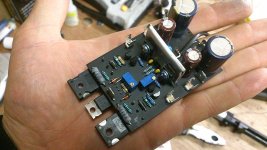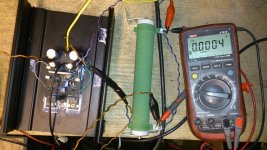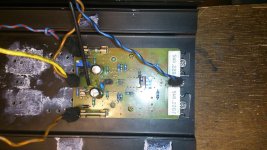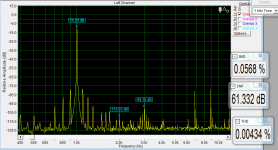Presently I am making basic version form first post. Yesterday I made pcb, but I see it will be much work with drilling - I made 6 chanels for active speakers
I think amp is so simple i look so good on measurements so its worth it do it
Regards
I think amp is so simple i look so good on measurements so its worth it do it
An externally hosted image should be here but it was not working when we last tested it.
An externally hosted image should be here but it was not working when we last tested it.
An externally hosted image should be here but it was not working when we last tested it.
Regards
Nice!
I've got some N-channel IRFP250N only.
Could anyone draw a variant of this circuit to fit only N-channel hexfet outputs?
Thanks!
In that case it will not be symmetrical, and one of the important aspects of this design is symmetry.
There you go - schematic with double bootstrap for vas stage.
Very nice! I'm excited to hear the result of this amp my friend...😉
I am not able to compare sq at the moment but I must say that irfp version sound excellent, only one think I can notice is that bass is bit different.
I must admit that HexFets, although considered unsuitable for audio, sound excellent to me. In fact, I am tempted to say that I like their sound even more than the sound of BJTs and even Lateral Mosfets. In this particular circuit their tendency to oscillate (with catastrophical results concerning loudspeakers tweeters) is prevented in good measure by current feedback topology. The only drawback is that amp must be somewhat more complex because of the bias servo.
Bellow results:
THD
Measurement is allways with amplitude 20V just to compare ....
Artifacts notwithstanding these are very nice results congrats 🙂
20volts - is that rms, peak or pk- pk ?
THD
Measurement is allways with amplitude 20V just to compare ....
Artifacts notwithstanding these are very nice results congrats 🙂
20volts - is that rms, peak or pk- pk ?
Bellow results:
THD
Measurement is allways with amplitude 20V just to compare ....
Artifacts notwithstanding these are very nice results congrats 🙂
20volts - is that rms, peak or pk- pk ?
20V is output amplitude (p-p voltage).
Bellow not tested 3 pairs board (you can cut off few o/p transistors with scisors anyway).
Currently I am working on BJT output version.
Need some time to show the results.
Attachments
Updated files for builders.
Attachments
Last edited:
Hi Borys,
Can you share the layout version as per attached photo, i could not find the same version on the photo have been posted.
Thanks
Regards,
I advice you to build version v6.1.
But anyway there is board v2 (prototype from the first post).
Version v7.1 is with bootstrap and multiple pairs of outputs (just cutt one or two pairs off if you do not need more).
I didnt have a chance to build v7.1 board so far but it is upgraded v6.1 (few more pairs at output and bootstrap)
If you need higher supply voltage make sure that input pair is replaced with something else.
Attachments
Very nice offset,...
Borys, all great
Have new VSSA variant to try sometime,
V 6.1 or 7.1 with multiple output,
OK, I will look at that 😎
Borys, all great

Have new VSSA variant to try sometime,
V 6.1 or 7.1 with multiple output,
OK, I will look at that 😎
Another version prototype board.
Outputs 2sc5200, 2sa1943, I have made some pulse response tests and must say this is the fastest bjt I have ever had.
I think I can make and universal board that irfp and bjt outputs can be used.
I have made one version with irfp and bd139 as bias compensation and this should work.
When I find some time I will post results.
The bd139 and 140 arent the fastest devices but cheap and availible everywhere. I might try somethink faster in vas stage.
Outputs 2sc5200, 2sa1943, I have made some pulse response tests and must say this is the fastest bjt I have ever had.
I think I can make and universal board that irfp and bjt outputs can be used.
I have made one version with irfp and bd139 as bias compensation and this should work.
When I find some time I will post results.
The bd139 and 140 arent the fastest devices but cheap and availible everywhere. I might try somethink faster in vas stage.
Attachments
Another version prototype board.
Outputs 2sc5200, 2sa1943, I have made some pulse response tests and must say this is the fastest bjt I have ever had.
I think I can make and universal board that irfp and bjt outputs can be used.
I have made one version with irfp and bd139 as bias compensation and this should work.
When I find some time I will post results.
The bd139 and 140 arent the fastest devices but cheap and availible everywhere. I might try somethink faster in vas stage.
That's quite interesting as i have some nice onsemi different device laying on shelves, could you provide some more details?
Marc
No worries, I will putt some more details after I will do more test, but now I am not able to do more tests becouse amp is playing so nice that I do not want to turn it off.
No worries, I will putt some more details after I will do more test, but now I am not able to do more tests becouse amp is playing so nice that I do not want to turn it off.
Than forgett "the more test"....😀😀😀 and publish details😉😉😉
Marc
I have to do very small modyfications only. I left some space on the board for compensation caps on driver stage - but they are not required.
I do not know if 25mA bias for driver stage is ok (should be fine, tranies are on most linear point anyway).
Maybe I will put something faster for vas I do not know yet (bd139 and 140 at the moment are doing their job).
There is no thumb plop on power on, amp is dead silent with input not connected (even if you stick the speaker into ear).
I do not know if 25mA bias for driver stage is ok (should be fine, tranies are on most linear point anyway).
Maybe I will put something faster for vas I do not know yet (bd139 and 140 at the moment are doing their job).
There is no thumb plop on power on, amp is dead silent with input not connected (even if you stick the speaker into ear).
Attachments
Another version prototype board.
Outputs 2sc5200, 2sa1943, I have made some pulse response tests and must say this is the fastest bjt I have ever had.
I think I can make and universal board that irfp and bjt outputs can be used.
I have made one version with irfp and bd139 as bias compensation and this should work.
When I find some time I will post results.
The bd139 and 140 arent the fastest devices but cheap and availible everywhere. I might try somethink faster in vas stage.
Wonderful borys...
 this is what i'm waiting for "VSSA in BJT"😉....
this is what i'm waiting for "VSSA in BJT"😉....will wait your final updates...
- Home
- Amplifiers
- Solid State
- FET-hex explendit amplifier



